AMD Frame Pacing Explored: Catalyst 13.8 Brings Consistency to Crossfire
by Ryan Smith on August 1, 2013 2:00 PM ESTCatalyst 13.8 Results in Summary
For this article we’ve decided to do things a bit differently and lead in with a summary of our results, rather than starting with detailed results and then going to a summary. Based on past feedback most of you want to quickly know whether this works at all and how well it works, which is something we can quickly cover first before diving into individual games.
We’ll start with the graph that is of the most importance: delta percentages on a 7990, comparing Catalyst 13.6b2 to Catalyst 13.8b1 with frame pacing enabled.
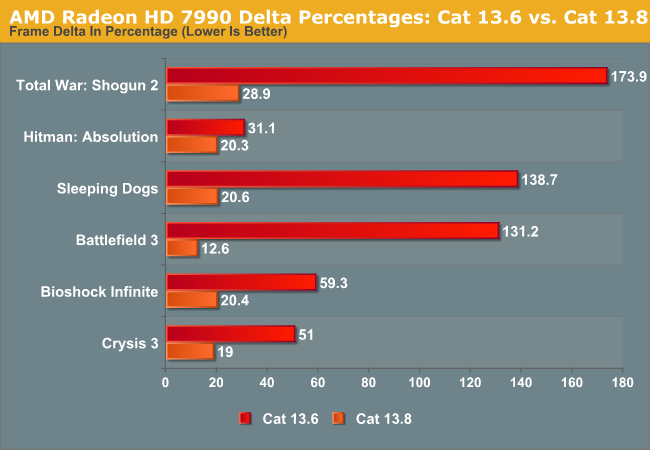
The results, quite frankly, speak for themselves. In roughly half of our 6 games AMD had absolutely absurd frame pacing on Catalyst 13.6. Total War, Sleeping Dogs, and Battlefield 3 all had massive pacing issues that were the result of second frames coming far too soon after first frames, leading to a high instance of “runt” frames – that is frames that are only shown for an incredibly short period of time before being replaced with a newer frame. These are the games where micro-stuttering and/or the feeling of lower frame rates would be the most apparent.
Earlier we decided that our cutoff would be 15%-20% for an “acceptable” range for delta percentages on a multi-GPU setup, and with the exception of Total War: Shogun 2 (the only non-action game in this collection), AMD has just managed to hit that. How smooth this is going to be perceived is going to vary on a person-by-person basis, but this is right where we’d say micro-stuttering and other issues become generally unnoticeable.
For the more visually inclined, we’ve also quickly cooked up frame time graphs in FCAT showing the two 7990s. The full series is below, but we’ll print in full the Total War: Shogun 2 graph in full since it was one of the bigger problem cases for AMD’s cards without frame pacing. Shogun doesn’t have any scene transitions, but it does have some snap camera movements that leads to a clear separation between scenes. In each scene we can clearly see the much lower variability with Catalyst 13.8 with frame pacing turned on, as opposed to 13.6 with frame pacing turned off.
Similarly, turning off frame pacing results results in Catalyst 13.6-like behavior, with much higher variability compared to having frame pacing turned on.
Moving on, the next question on most readers’ minds will probably be performance. What’s the performance sacrifice for using this new frame pacing mechanism? AMD said that the performance hit should be non-existent, and strictly speaking within Catalyst 13.8 that’s true, as we get identical frame rates with it on or off. However compared to Catalyst 13.6 we are seeing a performance regression.
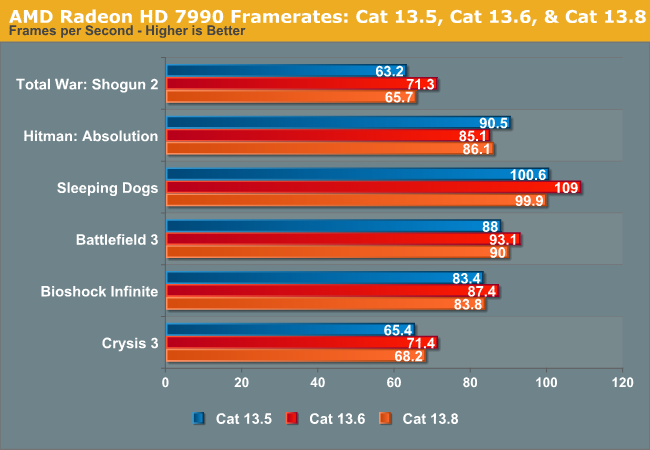
With the exception of Hitman: Absolution, performance is down across the board on 13.8 versus 13.6. The specific performance losses vary on the game, but we’re looking at 5-10%. However compared to the 13.5 launch drivers and again with the exception of Hitman AMD’s performance has held constant or increased. So at the very least when it comes to frame rates AMD is no worse off than they were at the launch of the 7990.
Our next summary graph is plotting the 7970GE against a pair of 7970GEs in Crossfire, to take a fresh look at AFR (Crossfire) versus a single GPU. Our editorial position has been and remains that we favor a single larger GPU over a pair of smaller GPUs when this approach is practical, and this chart demonstrates exactly why.
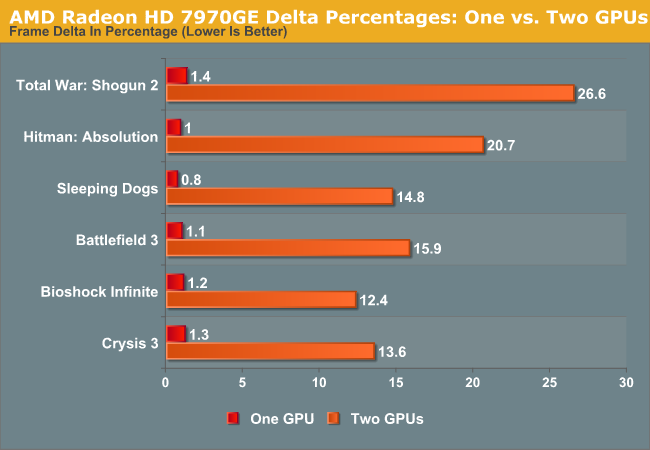
The delta percentages on the single 7970GE are all under 2%, versus 12%+ for the Crossfire setup. AFR simply cannot match the consistency of a single GPU at this time, which is why a high AFR is best left to being pursued after single-GPU performance has been exhausted.









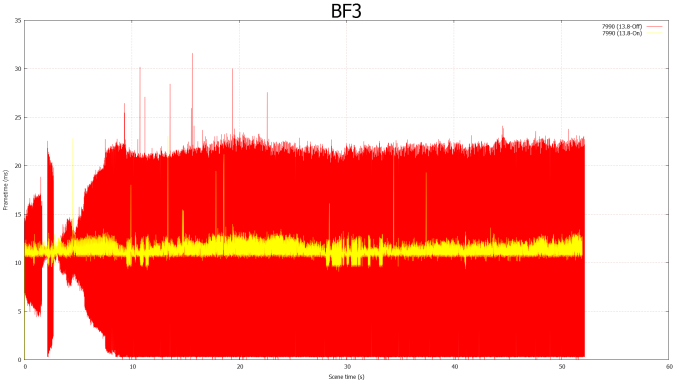
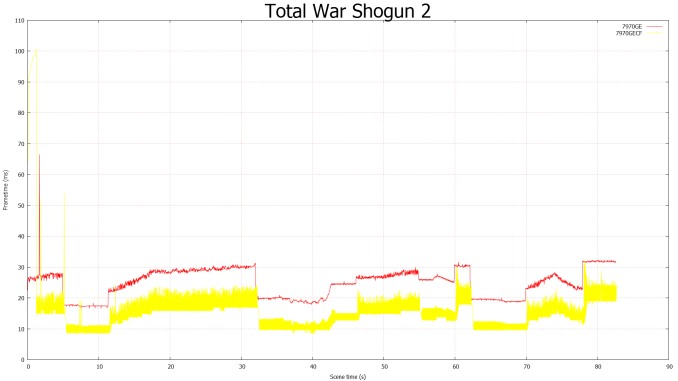














102 Comments
View All Comments
chizow - Wednesday, August 7, 2013 - link
There was discussions of microstutter on various forums associated with multi-GPU, but PCGH was the first site to publish it's findings in detail with both video evidence and hard data. From what I remember, they were the first to develop the methodology of using FRAPs frametimes and graphing the subsequent results to illustrate microstutter.BrightCandle - Friday, August 2, 2013 - link
One of the most shocking revelations to me is that AMDs quality assurance did not include checking the output of their cards frame by frame. I had always assumed that both NVidia and AMD had HDMI/DVI/VGA recorders that allowed them to capture the output of their cards so they could check them pixel by pixel, frame by frame and presumably check they were correct automatically.Such a technology would clearly have shown the problem immediately. I am stunned that these companies don't do that. Even FCAT is a blatantly blunt tool as it doesn't say anything about the contents of the frames. We still don't have any way to measure end to end latency for comparison either. All in all there is much to left to do and I am not confident that either company is testing these products well, its just I couldn't believe that AMD wasn't testing theirs for consistency (it was obvious when you played it something was wrong) at all.
krutou - Friday, August 2, 2013 - link
AMD is in the business of being the best performance per price entry in every market segment. Technology and quality come second.How often does AMD introduce and/or develop technologies for their graphics cards? The only two that come to mind are Eyefinity and TressFX (100 times more overhyped than PhysX).
Death666Angel - Saturday, August 3, 2013 - link
I think ATI had tessellation in their old DX8 chips. nVidia bought PhysX, so that shouldn't count. But I don't really see how having exclusive technology usable by a single GPU vendor is anything good. We need standardization and everybody having access to the same technologies (albeit with different performance deltas). Look at the gimmicky state of PhysX and imagine what it could be if nVidia would allow it to be fully utilized by CPUs and AMD GPUs?krutou - Saturday, August 3, 2013 - link
Because OpenCl and TressFX are doing so well right?bigboxes - Sunday, August 4, 2013 - link
March on, fanboi.JamesWoods - Sunday, August 4, 2013 - link
If you think that is all AMD/ATI has ever done for graphics then you sir, are ignorant. I was going to use a more degrading word there and thought better of it.Will Robinson - Friday, August 2, 2013 - link
LOL...what a load of tosh."NVDA had to take them by the hand"?
You and Wreckage ought to post in green text.
chizow - Friday, August 2, 2013 - link
Agree with pretty much of all of this, although I would direct a lot of the blame on AMD's most loyal, enthusiastic supporters as well. Every time microstutter was mentioned and identified as being worst with AMD solutions, AMD's biggest fans would get hyperdefensive about it. If those most likely to have a problem were too busy denying any problem existed, it really should be no surprise it was never fixed.And this is the result. Years of denial and broken CF, finally fixed as a result of the scrutiny from the press and laughter of Nvidia fans which brought this to a head and forced AMD to take a closer look and formulate a solution.
EJS1980 - Friday, August 2, 2013 - link
"Truth favors not one side."